Queens of The Court: Billie Jean King – The Heart and Stomach of a King
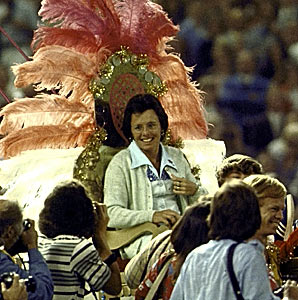
Women's Professional Tennis is what it is today thanks to Billie Jean King
A tribute to a personal heroine who celebrates her 66th birthday on 22nd November.
A first impression
What was it about one particular woman, wielding her wooden racket in the black and white world of 1960s television, that imprinted itself in this fan’s memory? She came from another country, and she played a game I had barely learned to understand, let alone master.
To me, she looked middle-aged even though still in her early 20s. She was ordinary in appearance but unusual in demeanor.
I knew nothing of her background nor of her achievements in tennis—other than she had just beaten the homely, and British, Ann Jones. But once I heard her name, I never forgot it.
Billie Jean King.
Her story has been simmering in the bloodstream ever since, because her name takes me back to my very first monochrome memories of tennis and of Wimbledon—for it was only Wimbledon that made its way into British living rooms back then.
These were impressionable years for a girl heading towards adolescence. It was the uncomfortable realisation that my mother seemed quite embarrassingly enamoured of the Santanas and Newcombes. It was also the uncomfortable realisation that King was being undermined by that mother’s slights about her appearance, her manner, and her attitudes.
It’s in unexpected places that children on the verge of adulthood have their opinions formed, and King was one of those places.
I immediately responded to her and the way she played. She had a powerful, nimble, forward-moving game. She was as fit as a flea. She had little vanity but great pride. She didn’t conform to the elegant ideal of Margaret Court, nor the girl-next-door safe of Jones, and certainly not to the pretty new star on the block, Evonne Goolagong. She wore glasses, was short, and often battled with her weight.
All of this was strangely reassuring to a girl bombarded by the glamor of the “swinging ’60s,” Twiggy, and Sgt. Pepper.
But King’s absence of glamor allowed her strong personality and talent to take centre stage. By the time King, then still only 23, was having her impact on this fan in England, she had begun not only to stamp her achievements on the tennis record books, but also to make her mark in social and political issues off court.
It started with the tennis
No, it started with her name.
When she was born, in Long Beach, CA in 1943, Billie Jean was to be Michelle Louise. But her father, Bill Moffitt, was away at war, and so her mother named her baby daughter in his honour.
King had a conservative, working-class upbringing, but very soon showed a special blend of two important strands. She had natural sporting ability, and she was bright. The young Billie Jean could have gone to Stanford had her parents been able to afford it. Instead she went to California State University in Los Angeles.
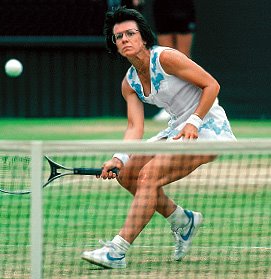
Billie Jean King won 39 Grand Slam titles, including 12 singles titles.
She had her first tennis lesson at the age of 11 and was so hooked that she bought her first tennis racket for eight dollars, using money she had saved up from odd jobs.
“I knew I had found my destiny. I wanted to be the No. 1 tennis player in the world.”
She claimed that, by 12, she already saw things she wanted to change, and knew that if she could be No. 1, people would listen. “It was all white people, dressed in all white clothes, playing with white balls before a crowd of polite observers. I wanted people to get excited, to be fans and participants, not observers.”
At 15, she entered her first U.S. Open. Then in 1961, at just 17, she played at Wimbledon. That occasion marked the very last time she failed to reach at least the singles quarterfinals, though she continued to compete at her favorite tournament until 1983. She didn’t, however, come away empty-handed in 1961: She won the first of her 14 doubles titles.
By 1963, she had reached Wimbledon’s singles final, and by 1966 she was the singles champion.
In the year that she reached out to one girl in England—1967—she won the singles, doubles and mixed doubles at both Wimbledon and the US Open. She went on to win the Australian Open as the year turned to 1968 (one of the rare times she played that event) and then won Wimbledon again.
By the end of 1968, she needed knee surgery (as she would do twice more in her career). That did not stop her playing, in 1970, one of the greatest Wimbledon finals against long-term adversary, the towering Court. It was a straight sets loss for King, but the women played 46 games: 14-12, 11-9.
In 1972, King added her only French title to further Wimbledon and U.S.Open wins.
Her style of play illuminated not only her lack of the enthusiasm for, and success on, clay, but spoke volumes about her character.
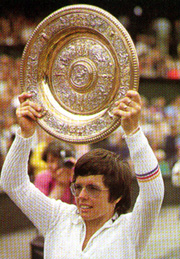
King won the Wimbledon singles crown six times.
She was a hard-hitting shot maker, and a great volleyer despite her 5’4″ stature. She felt her forehand down the line was weak, so she made a point of hitting it more often. She was a woman to tackle problems head on, a characteristic that pigeonholed her as aggressive rather than driven or courageous.
“Any woman who wants to achieve anything has to be aggressive and tough, but the press never sees us as multidimensional.” It took many more years before the media truly appreciated the multifaceted King.
Breaking down the barriers one by one
While King was embarking on the golden road to tennis fame, she was also finding out about the ways of the world. At university, where she was already the most lauded athlete, she met her future husband, Larry King. It was he who pointed out to her that he had a tennis scholarship when she did not solely because she was a woman. The campaign for equal rights beckoned.
First, she took on what she called the “shamateurism” accorded the women’s tour, a world where the top players were paid under-the-table fees to grace the major tournaments rather than being paid as professionals.
In 1970, she joined the new Virginia Slims Circuit, the first women-only tennis tour. She helped to form the Women’s Tennis Association (W.T.A.) in 1973, and a year later, she founded the Women’s Sports Foundation dedicated to advancing women’s sports.
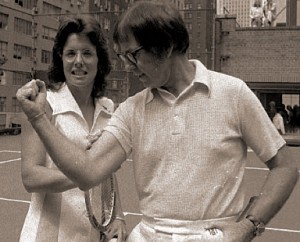
King's straight set victory over Bobby Riggs was watched by more than 50 million people.
As the first W.T.A. president, King threatened to lead a boycott of the 1973 U.S. Open if female players weren’t awarded the same prize money as the men. As a result, it became the first Slam to do just that.
Weeks after the Open, King took the fight for gender equality by the throat in possibly her most famous match, known as the “Battle of the Sexes.” The 55-year-old Bobby Riggs was a former Wimbledon and U.S. Open champion, and had challenged the top female players as a publicity stunt, saying that “women just don’t have the emotional stability for the game.”
In May, he had beaten Court in what became known as the “Mother’s Day Massacre.” King had originally turned down Riggs’s offer to play, but after seeing Court embarrassed 6-2, 6-1 by Riggs, she felt she needed to take up his challenge. “I thought it would set us back 50 years if I didn’t win that match.”
His comment? “I want the women’s lib leader.”
The records of King and Court between 1966 and 1975 had followed similar paths. One or both of them played 35 of the 40 Slam singles tournaments held during this period, and together they won 24 of them.
They were like chalk and cheese in looks, in playing style, and in their personal lives. But they became united in this common cause.
After studying a tape of Court’s match, King became incensed that Riggs had presented Court with a bouquet of flowers before it started. “She should have belted him over the head with the flowers rather than accept them!” What Court did do, however, was exchange notes with King on tactics.
The match became the most watched—by 50 million—in tennis history.
But even there, King had an eye to equality. She noted that not a single sportswriter covering the event was a woman. She knew her worth and used it to advance her cause. A couple of days before the match, she told the head of ABC, who had paid $750,000 for the broadcasting rights, that she wouldn’t play if the network used Jack Kramer, whom she believed to be anti women’s tennis, in the commentary box.
She won. She also won the match, 6-4, 6-3, 6-3.
This is, perhaps, an appropriate point to look at King’s views on the three-set versus five-set debate. She never had an issue with men and women playing the same length of match—as her Riggs encounter proved. What she did, and continues to, favor is the three-set format for all players, particularly in the context of the modern game.
“I want every player to play as long as possible and I think the long five-setters are taking a toll on the longevity of the men’s careers…I think two out of three is better so we can see more of them.”
Courage and controversy
King was always unafraid to take on the establishment in her professional life. But she eventually had to face it in her personal life too.
She was one of the first professional sports woman to admit she was gay, or rather she was forced out of the closet, in 1981, by the revelations of her P.A., Marilyn Barnett. The greatest barrier to admitting her sexuality sooner had been her parents. It’s worth quoting her own words about what was clearly a major internal conflict.
“One of my big goals was always to be honest with my parents and I couldn’t be for a long time. I tried to bring up the subject but…I was pretty easily stopped because I was reluctant anyway. I ended up with an eating disorder that came from trying to numb myself from my feelings. I needed to surrender far sooner than I did.”
On top of the family conflict, she feared the homophobia that was more widely prevalent: “I had people tell me that if I talked about what I was going through, it would be the end of the women’s tour.” As it was, she estimates that the revelation cost her millions of dollars in endorsements.
King and her husband had experienced controversy before, when he revealed, without her permission, that she’d had an abortion in 1971. Nevertheless, they rode out their relationship together until they divorced in 1987. After they agreed to pursue separate relationships, he asked her to be godmother to any child he may have, and she is.
Still embracing challenge and change
King retired from singles tennis in 1984, and became commissioner of World Team Tennis, which she and her husband had helped to create in 1973. She still serves on the board of the Women’s Sports Foundation, which in 2008 opened the Billie Jean King International Women’s Sports Center, the first museum dedicated to women’s sports.
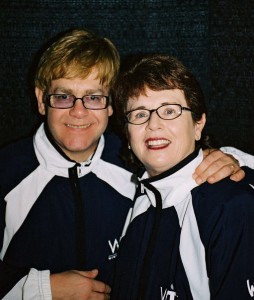
Elton John's song "Philadelphia Freedom" was written as a tribute to Billie Jean King.
She, along with John McEnroe, still strives to bring tennis to the masses, to make it fun and accessible. After 30 years, she has brought the World Team Tennis brand back to New York, with the intention of getting locals up close and personal, at an affordable price, to the big tennis stars such as Venus and Serena Williams.
It comes as no surprise that she welcomes technological advances as enthusiastically as social ones. The new roof over Wimbledon’s Centre Court, far from being “sacrilege”, is “beautiful…like a functional piece of contemporary art.”
The powerful modern rackets help players in the local park to “feel like they can, even for a few points, hit as cleanly as the pros.”
She’s a great supporter of “hawkeye” technology, both for the fairness it brings to the tennis and the excitement it brings to the fans.
“With all of the information, equipment advances and technology…players get better every generation…I would be having so much fun if I was playing today, my personality would fit the modern game!”
Yet she still sees much to achieve.
She works with long-time friend Elton John on AIDs awareness.
She is co-founder of GreenSlam, an environmental initiative for the sports industry.
And she still sees discrimination against gay women in the media, and even within the W.T.A. where the names of players’ male partners are mentioned, but not the females’ partners.
And still she inspires
What was it, then, from this catalogue of achievement, that made such an impression on a very young, very unworldly British schoolgirl all those years ago?
No-one could foresee that King would win 129 singles tournaments, 12 of them in Grand Slams, nor that she would claim a record-setting 20 Wimbledon titles.
It was impossible to imagine that the prestigious home of U.S. tennis would be named in her honor, or that she would receive the Presidential Medal of Freedom for her work on the rights of women and gays.
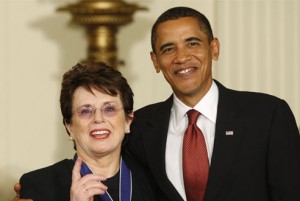
King was awarded the Presidential Medal of Freedom by President Obama.
Her worldwide status could be measured by awards: the Sunday Times Lifetime Achievement Award; the Champion of Justice award from the Public Justice Foundation; the Arthur Ashe Courage Award; and many more.
Whatever it was, the emotion was rekindled by a brief, live encounter at the eponymous U.S. National Tennis Center. King was, as she has always done, enthusing the public about tennis with a new Champions Invitational event that pitted three co-ed teams against one another in her beloved W.T.T. format.
A crowd spanning all ages gathered around the perimeter of one of Flushing Meadows’ outside courts to enjoy a line-up of Grand Slam champions and finalists under the leadership of three of the greats of the game: Pat Cash, Ivan Lendl and, the real star of the show, Billie Jean herself.
Looking trim, and unexpectedly petite, in black tracksuit and trademark spectacles, King lounged casually in her team’s corner, just meters from the excited spectators. She was the quiet center of the hubbub, yet her name was on everyone’s lips. If I had thought I was the only person in awe of her presence, I was sorely mistaken.
She was asked recently what it was about her life that gave her satisfaction: “All the off-the-court stuff. After I die, it will still be there, affecting people’s lives.”
Never was a truer word spoken.
The title refers to words attributed to Queen Elizabeth 1: “I know I have the body of a weak and feeble woman, but I have the heart and stomach of a king.”
Read other articles in this series about women and their contributions to the game:
Admirando a dedicação que você tem com o seu site
e as informações profundas que você oferece! Você escreve novas informações que não são as os mesmos dados que encontro em
outros blogs na internet. Fantástica ! Estou adicionando
seu feed RSS na minha conta do Google.